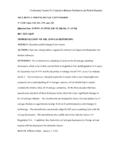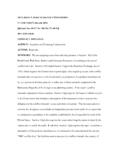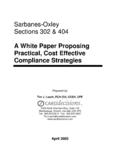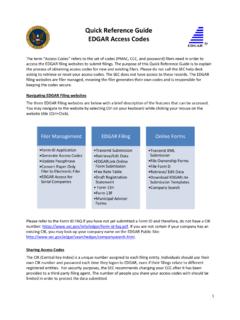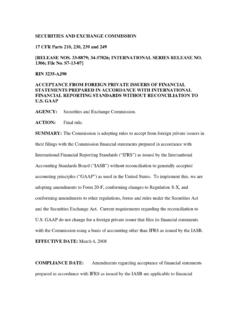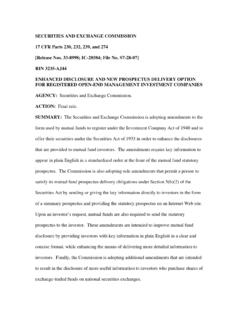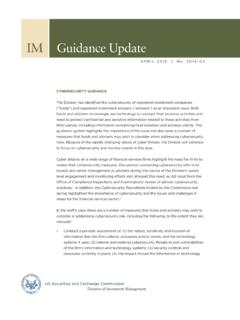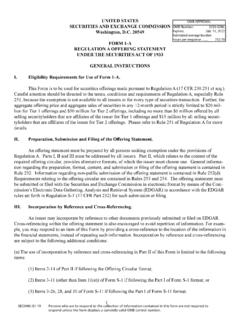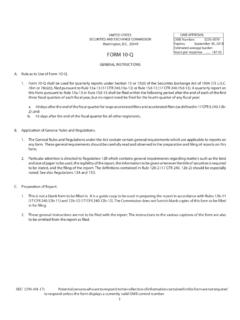Transcription of Investor Bulletin: American Depositary Receipts
1 Investor bulletin : American Depositary ReceiptsThe SEC s Office of Investor Education and Advocacy is issuing this Investor bulletin to educate investors about American Depositary Receipts ( ADRs ). An ADR is a security that represents shares of companies that are held by a Depositary bank outside the United States ( ). What is an ADR? ADRs allow investors to invest in companies and give companies easier access to the capital markets. Many issuers use ADRs as a means of raising capital or establishing a trading presence in the The company may sometimes be referred to as a foreign private issuer. The first ADR was created in 1927 by a bank to allow investors to invest in shares of a British department store. Today, there are more than 2,000 ADRs available representing shares of companies located in more than 70 countries.
2 An ADR is a negotiable certificate that evidences an ownership interest in American Depositary Shares ( ADSs ) which, in turn, represent an interest in the shares of a company that have been deposited with a bank. It is similar to a stock certificate representing shares of stock. The terms ADR and ADS are often used interchangeably by market participants. ADRs trade in dollars and clear through settlement systems, allowing ADR holders to avoid having to transact in a foreign currency. An ADR may represent the underlying shares on a one-for-one basis, or may represent a fraction of a share or multiple shares. For example, for one company, an ADR may represent several shares of the underlying security, while for another company, an ADR may represent a fraction of the underlying security.
3 The use of a ratio allows ADRs to be priced at an amount more typical of market share prices. ADRs are created by a Depositary bank when the company, or an Investor who already holds the underlying securities, delivers them to the bank or its custodian in the company s home country. The bank will issue ADRs to the Investor in the and the Investor will be able to re-sell the ADRs on a exchange or the over-the-counter market. ADR holders may also surrender ADRs in exchange for receiving the shares of the company. These transactions are generally performed by brokers and other types of investors who are active in foreign securities markets. ADRs may be sponsored or unsponsored. Sponsored ADRs are those in which the company enters into an agreement directly with the Depositary bank to arrange for recordkeeping, Investor Assistance (800) 732-0330 of shareholder communications, payment of dividends, and other services.
4 An unsponsored ADR is set up without the cooperation of the company and may be initiated by a broker-dealer wishing to establish a trading market. An ADR, however, may not be established unless the company is either subject to the reporting requirements under the Securities Exchange Act of 1934 or is exempt under the Act. ADRs are always registered with the SEC on a Form F-6 registration statement. Disclosure under Form F-6 relates only to the contractual terms of deposit under the deposit agreement and includes copies of the agreement, a form of ADR certificate, and legal opinions. A Form F-6 contains no information about the company. If a foreign company with ADRs wishes to raise capital in the United States, it would separately file a registration statement on Form F-1, F-3, or F-4.
5 If a foreign private issuer seeks to list ADRs on a stock exchange, it would separately file with the SEC a registration statement on Form 20-F. Registration statements used to raise capital or list ADRs on an exchange are required to contain extensive financial and non-financial information about the issuer. Market participants have generally categorized ADRs into three levels, depending on the extent to which the foreign company has accessed the markets: Level 1 ADR programs establish a trading presence but may not be used to raise capital . It is the only type of facility that may be unsponsored and, as a result, may be traded only on the over-the-counter market. Form F-6 would be the only form required to be filed. No information about the issuer would be available on the SEC s EDGAR system; information should be available on the issuer s website.
6 Level 2 ADR programs establish a trading presence on a national securities exchange but may not be used to raise capital . Again, Form F-6 would be used to register the ADRs. The company is required to register and file annual reports on Form 20-F with the 3 ADR programs may be used not only to establish a trading presence, but also to raise capital for the foreign issuer. A registration statement on Form F-1, Form F-3, or Form F-4 would be filed in order to offer the ADRs. The company would be required to also file annual reports on Form fees are charged to ADR investors? As a matter of course, an ADR Depositary bank may be authorized under the deposit agreement relating to the ADRs to charge a fee, called a custody fee, for the work it performs on the ADR.
7 ADR Depositary banks charge holders of ADRs custody fees, sometimes referred to as Depositary Services Fees, to compensate the Depositary banks for inventorying the shares and performing registration, compliance, dividend payment, communication, and recordkeeping services. A common practice for collection of the custody fee is for the ADR Depositary bank to subtract the amount of the fee from the gross dividends paid by the bank to ADR holders. Typically, the Depository Trust Company, (DTC) will announce both the gross dividend rate and the net dividend rate after deduction of the ADR custody fee. The ADR Depositary banks pay DTC the net dividend, and DTC allocates the net dividend to its users. However, a number of ADR issues do not pay periodic dividends, which prevents the fees from being collected through the above-described mechanism.
8 In this case, DTC charges the fee to its users ( , banks and broker-dealers) who pass them on to their customers. Depositary banks may charge other fees, such as relating to the distribution of dividends, foreign currency exchange, voting of shares, and other matters. Investor Assistance (800) 732-0330 should investors do before investing in ADRs? Like any other investment, you should learn as much as you can about a company before you invest. Research the political, economic, and social conditions in the company s home country so you will understand better the factors that affect the company s financial results and stock price. You should understand that companies are subject to financial and other disclosure requirements that differ from those required of public companies.
9 Except for the annual report on Form 20-F, companies are generally only required to disclose what is required in their home country. Any disclosure may also not be as extensive or comparable to that of public companies. Prior to investing in an ADR, investors should ask their broker-dealer what fees are charged to them as ADR investors. Typically, fees are assessed per ADR. For example, 1000 ADRs could be assessed a fee ranging from $20 to $50. Investors should review the fees reported in the Form F-6 registration statement under the Securities Act of 1933 available through the SEC s web site at at no charge. Fees can be viewed in the section of the registration statement typically titled, Description of American Depository Shares or Description of American Depository Receipts .
10 The websites of Depositary banks that are active in the also contain information about investing in ADRs and serve as a source of information for investors. 2 RELATED INFORMATION For more information on ADRs and international investing, please visit the SEC s ADR Fast Answer and read our publication on the basics of international investing, which covers the risks of investing internationally and how to get more information about foreign companies and Office of Investor Education and Advocacy has provided this information as a service to investors. It is neither a legal interpretation nor a statement of SEC policy. If you have questions concerning the meaning or application of a particular law or rule, please consult with an attorney who specializes in securities Assistance (800) 732-0330 August 20123
